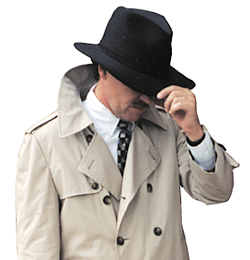About That Loudness Thing...

You might not have noticed, but… it's getting harder to hear around here.
Not that I'm hard of hearing, mind you. (This is how rumors get started.) What's getting harder, it seems to me, is the amount of work it takes to make TV shows so others can hear them.
Okay, so it's not really about being unable to hear the sound; it's about A) the ability to make the audio comply with specific laws and specifications; and B) to make it sound nice.
Part "B" I'm down with that. That's what we've always tried to do—at least those of us who were paying attention. It's Part "A" that's killin' me.
RECIPE FOR ALPHABET SOUP
I know it's hard to believe, but I don't pore over the Federal Register each morning, looking for trouble; but methinks you would have had to have spent the entire fall of 2009 on transmitter duty up on the mountain to have missed the reports on the progress of H.R. 1084, popularly referred to as the CALM (Commercial Audio Loudness Mitigation) Act. It's hard to imagine our legislators so bereft of crises that they turn to the annoyances of daily life to find busywork… but here it is, living proof: legislation, passed by both houses, which reminds the FCC (aka the Commish) to tell broadcasters to follow the (existing) rules. Sheesh!
And so begins the alphabet soup of television sound: H.R. 1084, victorious where its predecessor, H.R. 6209, failed; ATSC A/53 Annex B, section 5.5; ITU-R BS.1770; and AC3's spec for Leq(A). Got that? Need anything repeated?
Mostly, though, it all boils down to one little, English-language word: Loudness. I studied long and hard to learn to use specific, scientific-sounding terms like "gain," "modulation," and "amplitude" instead of simply saying "volume." And now I'm told to use the most amorphous, least specific term I've ever heard, which I'll call "that loudness thing."
Now that takes me back… way back, to when consumer audio equipment was called a "stereo" or a "hi-fi." I stuffed my pockets with the proceeds of my newspaper route and had a parent drive me to a local purveyor of consumer electronics—the appliance store—where I bought a floor model H.H. Scott-brand receiver. And there, on the front panel, next to one of the many knobs, sat a small slide switch labeled "Volume" and "Loudness." I was suspicious then, and I remain suspicious now.
A NOTION OF LOUDNESS
But semantics aside, I'm thinkin' that the loudness thing is a concept surrounding how sounds are perceived rather than the millivolt values we measure. And that's a valuable concept; how often do we sit staring at the meters, thinking, "I know the levels look right, but it sounds wrong!"
Enter our friends at Dolby, who seemingly have a solution for everything, although methinks they sometimes need to discover a problem first, which might benefit from that solution. It's a bit like the old adage that, "…if it wasn't for lawyers, we wouldn't need any."
Anyway, the Dolby geniuses helped our friends who make movies—"The Cinemah"—who had a similar problem with inconsistent audio levels, except that their patrons paid cash for tickets, and demanded satisfaction (unlike TV viewers, who potentially pay nothing, and demand satisfaction.)
Of course, that loudness thing doesn't entail every kind of loudness. It mostly means normalizing dialogue loudness.
Dolby's processing algorithm created a parameter termed "dialnorm"—guess what that stands for?—which arguably became the standard we use today for that loudness thing. And those are the juicy bits which formed the core of ATSC A/53 Annex B, section 5.5 (Dialogue Level): "The value of the dialnorm parameter in the AC-3 elementary bitstream shall indicate the level of average spoken dialogue within the encoded audio program." In short: The ATSC says you gotta do this.
Two problems, though: you need to be able to measure Leq(A), and I'll bet dollars to donuts that you can't do that yet; and you need to be able to fix it. For which, of course, you'll first need to be able to monitor it.
I PREDICT…
We ain't customarily in the business of shilling for hardware and software developers, but I will make a few predictions: In your mad Googling for Leq(A) monitoring solutions, you'll probably encounter Dolby's LM-100, the Neural Loudness Control, and the Linear Acoustic LQ-1000 in the hardware aisle; and as for software, there's the free "Audio Leak 3" for Mac, among others; and you ProTools folks will be looking for the "Signal Tools" plug-in, I bet. But you didn't hear it from me.
Yes, it's a pain in that place where the audio engineer most customarily rests; yes, there's something new to learn; and yes, it's gonna cost somebody a bunch 'o money. But outside of the legal things, and the regulatory things, and the technology things, implementing that loudness thing ultimately satisfies Part B up above… "make it sound nice"… and that's a good thing.
Mario Orazio is the pseudonym of a well-known television engineer who wishes to remain anonymous. E-mail him atmorazio@nbmedia.com.
Get the TV Tech Newsletter
The professional video industry's #1 source for news, trends and product and tech information. Sign up below.
